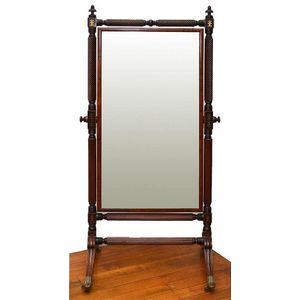Mahogany & Rosewood Veneer Wall Rack with Fretwork
You must be a subscriber, and be logged in to view price and dealer details.
Subscribe Now to view actual auction price for this item
When you subscribe, you have the option of setting the currency in which to display prices to $Au, $US, $NZ or Stg.
- Tier - One or more under-shelves of a table or cabinet.
- Mahogany - Mahogany is a dense, close grained red-coloured timber from the West Indies and Central America. It was first imported into Europe in the the early 18th century and its use continued through the 19th century. It was popular for furniture making because of its strength, the wide boards available, the distinctive grain on some boards, termed flame mahogany and the rich warm colour of the timber when it was polished.. The "flame" was produced where a limb grew out from the trunk of the tree, and this timber was usually sliced into veneers for feature panels on doors, backs and cornices.
Some terms used to describe mahogany relate to the country from which it originally came, such as "Cuban" mahogany, "Honduras" mahogany etc. However unless the wood has been tested the names assigned are more a selling feature, rather than a true indication of the timber's origin. - Rosewood - A dense timber that varies in shade to very light brown to almost black. When rosewood is cut and sanded the colour of the timber will turn black, and after polishing and exposure to daylight, the surface will gradually lighten over time to light brown with black streaks.
The name comes from the odour emanating from the timber when it is planed, sanded or cut.
Rosewood was very popular for use in Victorian furniture in the second half of the 19th century, and at that time most of the rosewood was imported from Brazil. However it also grows in India and Indonesia.
It is used in the sold for chairs and table legs, but for carcase furniture such as side cabinets and bookcases, and for table tops it is always used as a veneer.
This item has been included into following indexes:
Visually similar items

Vintage dumb waiter, with two shelves joined by turned supports, 76.5 cm wide, 47.5 cm deep, 96 cm high

An antique Victorian mahogany Trestle end towel rack, 19th century, with arching ends and pairs of turned supports to the shaped and splayed base with whorl terminals and supporting five horizontal rails, height 85 cm, width 76 cm, depth 32 cm

A 19th century brass inlaid mahogany cheval mirror the rectangular plate within twist turned supports with fleur de lys brass inlay, above scroll legs united by a cross stretcher, brass caps and castors, 194 x 97 cm

A Victorian mahogany dumb waiter, circa later 19th century. The top having a shaped and arched gallery and finials, with three tiers and turned supports and legs terminating in ceramic casters with brass hardware. Height 147 cm. Width 124 cm. Depth 46 cm
